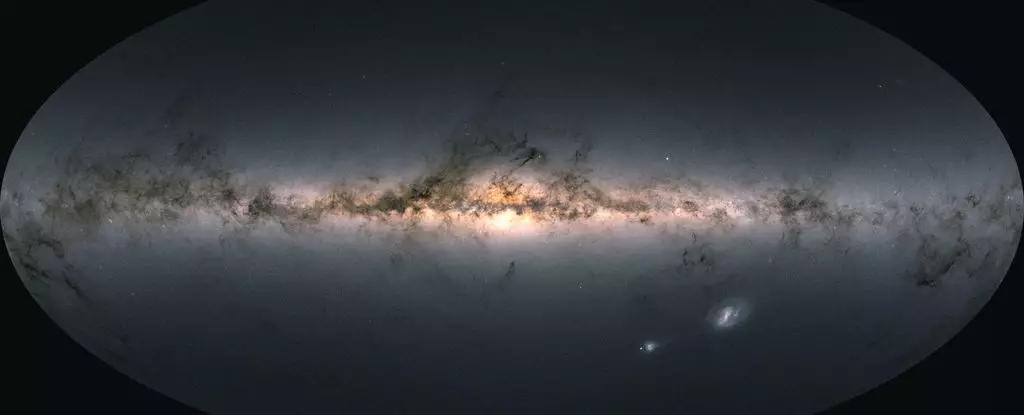The cosmos never ceases to amaze with its vastness and the untold mysteries it harbors. Recent findings suggest that a colossal black hole may lie within the Large Magellanic Cloud (LMC), a dwarf galaxy that orbits our Milky Way. At an estimated mass of 600,000 solar masses, the implications of this discovery, spearheaded by astrophysicist Jiwon Jesse Han and his team at the Harvard & Smithsonian Center for Astrophysics, are immense. The notion of an impending collision between the Milky Way and this black hole raises several intriguing questions about the evolution of black hole life cycles and galactic dynamics.
The LMC is an intriguing celestial body that has captured the interest of astronomers for years. With its electrons swirling in proximity to our galaxy—a gravitational dance that is expected to culminate in a collision in approximately two billion years—the presence of a supermassive black hole within it needs careful examination. Unlike more commonly observed black holes, which typically exhibit massive sizes exceeding a million solar masses, this specific black hole is nestled in a unique mass category. Understanding its nature offers astronomers a rare opportunity to deepen their knowledge of black hole formation—from the initial stages, where they form from collapsing stars, to the later phases, where they might attract and consume an enormous amount of matter.
Detecting black holes is a daunting task. They don’t emit light like stars, making it challenging to identify them unless they are actively consuming matter, which creates an intense radiative fever as particles heat up through collisions. Scientists often resort to indirect methods, such as investigating the movements of stars in their vicinity. The research team led by Han implemented a novel approach, diverting their attention from typical orbital patterns to a rarer phenomenon: hypervelocity stars. These stellar outliers move through space at incredible speeds, so much so that they could escape the gravitational pull of our galaxy altogether.
An interesting mechanism behind this process is known as the Hills mechanism, representing a three-body interaction that can yield hypervelocity stars when a black hole interacts with two stars. Exploring the velocities of these hypervelocity stars provides an exciting window into uncovering the properties of hidden black holes.
The Gaia space telescope, known for its painstaking work in mapping the positions and movements of stars in three dimensions, became a pivotal tool for Han and his colleagues. By analyzing data from 21 hypervelocity stars within the Milky Way’s outer halo, the researchers sought to identify the connection between these fast-moving objects and potential unseen black holes. Their efforts revealed that several of these stars originated from within the LMC, supporting the hypothesis of a hidden black hole exerting its gravitational influence.
Critically, this analysis provided exceptional insights; 16 of the hypervelocity stars were effectively traced back to their origins, with seven hailing from the vicinity of Sagittarius A*, the supermassive black hole at the center of the Milky Way, while the remaining nine were confirmed to have originated from the LMC. This correlation underscores the compelling evidence of a hidden black hole contributing to the stellar dynamics in our galactic neighborhood.
As we look ahead, the potential merger of the Milky Way and the Large Magellanic Cloud is an event that astronomers both anticipate and dread, given its distant timeline of two billion years. Yet, the contemplation of such a grand cosmic amalgamation raises profound questions about black hole growth. A successful encounter between the two will likely lead to the eventual collision and merging of the supermassive black holes at their centers.
This merger may enhance our understanding of how black holes evolve over time, particularly as they grow from smaller entities into behemoths of unimaginable mass. Continuous research and future observations will be critical in substantiating the existence of the black hole within the LMC and its properties, providing essential data to unravel the intricate tapestry of black holes and galaxies across the universe.
The potential discovery of a black hole in the Large Magellanic Cloud not only fascinates but also serves as a reminder of the intricate and dynamic nature of the universe. As astronomers strive to decode the celestial ballet among stars and black holes, they inch closer to answering timeless questions about the formation, growth, and ultimate fate of these enigmatic cosmic entities. The universe might well hold its breath as it delivers yet another chapter in the never-ending saga of galactic evolution.


Leave a Reply